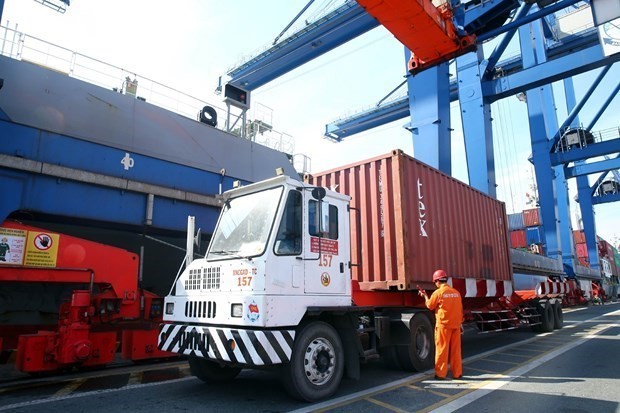
What RCEP means for Viet Nam
Latest
 |
| Along with establishing common standards for trade, rules for the origin of traded items, intellectual property, and e-commerce, RCEP is expected to eliminate trade barriers and tariffs. (Source: Global Times) |
New opportunities to sustain economic development
Along with establishing common standards for trade, rules for the origin of traded items, intellectual property, and e-commerce, RCEP is expected to eliminate trade barriers and tariffs, said Dr Erhan Atay, RMIT Senior Lecturer of International Business.
As COVID-19 brought severe challenges and disruptions to economies, Dr Erhan Atay believes “RCEP can provide an important opportunity for members to increase their exports and modernise standards."
RCEP can also be the source of motivation for local businesses to reach diverse customers across Asia-Pacific by being part of regional e-commerce networks.
“E-commerce and new digital services eliminate the borders and provide small players opportunities to access new customers across the globe," Dr Erhan Atay said.
According to him, Vietnamese businesses can utilise e-commerce to reach RCEP member countries in Asia-Pacific region as the worldwide demand for digital products, telecommunication items, and agriculture is increasing. "For example, there is a high demand in Australia for electronic products, crude oil, textile, footwear and furniture", he said.
“Vietnamese businesses can also benefit from imported raw materials and intermediatory or semi-finished inputs for production at a lower price than the pre-RCEP period," Dr Atay said.
To promote exports into RCEP countries, Dr Atay emphasised particular policies and guidance, especially for small and medium enterprises (SMEs).
“SMEs should concentrate on e-trade, small and niche markets that look for items Vietnamese industries can provide, acquire knowledge and expertise on e-commerce networks, regulations on quality control, international standards and import-export related policies of target markets," he said.
Challenges from harsh competition
At the same time, the country will face increased competition as entry into the domestic market of foreign products will become easier than ever before, according to RMIT International Business Associate Lecturer Dr Duy Dinh.
“Additionally, within new-generation Foreign Trade Agreements (FTAs), Viet Nam is making commitments to liberalise the field of trade in services further. Therefore, competition pressure will not be limited to the manufacturing sector but also the services sector due to enhanced market access conditions”, Dr Duy said.
As one of the fifteen members of RCEP, Viet Nam can take advantage of the reduced tariffs and non-tariff barriers, which means the level of protection in trade in goods has significantly decreased. Dr Duy Dinh cited an example as “the ASEAN Trade in Goods Agreement (ATIGA) has eliminated tariffs on various automobile products since 2018, and the Viet Nam-EU Free Trade Agreement (EVFTA) also cuts down tariffs in this sector remarkably”.
Dr Duy added “deeper regional integration urges local firms to adapt, innovate, and make use of new market opportunities and potential partnerships with foreign firms. Otherwise, it would be difficult for them to survive the harsh competition”.
 |
| By improving both in terms of technology adoption and labour skillsets, Viet Nam would export higher-value products while maintaining close control of the raw material supplies. (Illustrative photo - Source: VNA) |
Focus on higher-value products
Viet Nam’s government has recently made a decision approving a plan on the implementation of RCEP which aims to assign tasks and responsibilities to relevant agencies and organisations, decide on measures related to direction and administration, and other elements to implement this agreement fully and effectively.
Several improvements need to be carried out in Viet Nam in the coming years.
RMIT International Business lecturer Dr Santiago Velasquez said Viet Nam should focus on higher-value products while maintaining close control of raw materials.
“As a key player in the global supply chain, Viet Nam will continue to become more attractive for FTAs – both bilateral and multilateral – as other countries will tend to secure the flow of raw materials and consumer products," Dr Velasquez said.
“Viet Nam will continue to see opportunities from commodities and primary production industries. However, the most lucrative endeavours will emerge from higher-value manufacturing”, Dr Velasquez explained.
By improving both in terms of technology adoption and labour skillsets, Viet Nam would export higher-value products while still maintaining close control of the raw material supplies. As a result, these higher-value products would be highly competitive with respect to production, transportation, and FTA-alleviated import costs, he added.
The Vietnamese government would also need to continue restructuring the economy and focus on institutional reforms. A strengthened banking sector and better business environment would facilitate trade and enable firms to use the opportunities brought about by the FTAs.
While institutional reforms may take decades, and a short-term recommendation is expected for the year to come, the emphasis should be on how we manage to implement the agreement efficiently.
Dr Duy said improved information dissemination to firms, especially SMEs, should be the government's priority.
“Firms need to be well informed of RCEP from a business perspective: new market opportunities, challenges they may face, the support they may expect from the government, and what they need to do to gain benefits from these FTAs," he said.
“In addition to information dissemination, the government needs to focus more attention to capacity-building activities to help improve the competitiveness of domestic firms. Capacity-building activities should help firms realise their position in regional and global value chains and help them understand how to maintain that strategic position and gradually move up the value chain," he said.




















